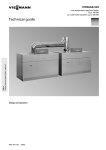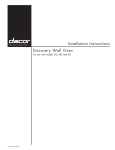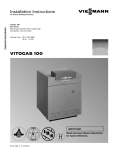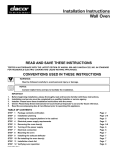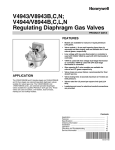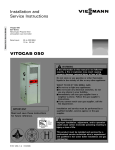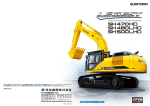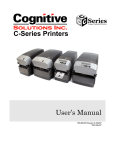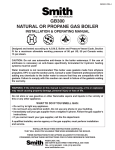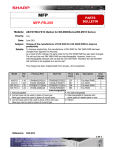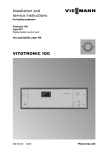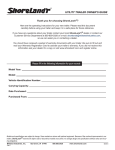Download Viessmann Vitogas 050 Rs Series Service manual
Transcript
Installation / Service Manual for Vitogas 050, RS Series Gas-fired, atmospheric cast iron boiler 550 to 1050 MBH / 161 to 308 kW IMPORTANT: READ AND SAVE THESE INSTRUCTIONS FOR FUTURE REFERENCE These instructions cover the installation, operation and servicing of the Viessmann Vitogas 50, RS series of cast-iron sectional atmospheric gas-fired hot water boilers. These instructions must be read thoroughly prior to installation. These instructions must be saved and made available to service technicians when required. Install boiler according to these instructions. The installation of this unit shall be in accordance with local codes or, in the absence of local codes, use CSA-B149.1 or .2 Installation Codes for Gas Burning Appliances for Canada. For U.S. installations use ANSI Z223.1. Always use latest editions of codes. Where required by the authority having jurisdiction, the installation must conform to the Standard for Controls and Safety Devices for Automatically Fired Boilers, ANSI/ASME CSD-1. These instructions must be placed in an envelope and affixed to the boiler. ® 5167 456 v1.2 03/2007 Contents: Page: Technical Data ..........................................................................3 Boiler Features .........................................................................4 Installation.................................................................................4 Gas Connections ......................................................................7 Water Connections ...................................................................8 Vent Connections ...................................................................10 Accessories ............................................................................10 Start-up and Operating Instructions ........................................11 Maintenance ...........................................................................13 Troubleshooting ......................................................................17 Piping Layouts ........................................................................18 Wiring Diagrams .....................................................................22 Installation Checklist ...............................................................24 Replacement Parts List...........................................................25 Assembly of cast-iron block using draw tool ...........................30 Viessmann Manufacturing Company Inc. 750 McMurray Road Waterloo, Ontario • N2V 2G5 • Canada Tel. (519) 885-6300 • Fax (519) 885-0887 www.viessmann.ca • [email protected] Viessmann Manufacturing Company (U.S.) Inc. 45 Access Road Warwick, RI • 02886 • U.S.A. Tel.: (401) 732-0667 Fax: (401) 732-0590 www.viessmann-us.com • [email protected] This “Attention” symbol is located beside all important safety recommendations. Please follow the instructions in detail to avoid property damage, severe personal injury, or loss of life. Warning: If the information in this manual is not followed exactly, a fire or explosion may result causing property damage, personal injury, or loss of life. Do not store or use gasoline or other flammable liquids in the vicinity of this or any other appliance. WHAT TO DO IF YOU SMELL GAS • Do not try to light any appliances. • Do not touch any electrical switches, do not use any phone in your building. • Immediately call your gas supplier from a neighbor’s phone. Follow the gas supplier’s instructions. • If you cannot reach your gas supplier, call the fire department. Installation and service must be performed by a qualified installer, service agency or the gas supplier. Warning: The installation, adjustment, service, and maintenance of this boiler must be done by a licensed professional service technician who is qualified and experienced in the installation, service, and maintenance of commercial gas-fired hot water boilers. There are no user serviceable parts on the boiler, burner, or control. Failure to heed this warning can cause property damage, severe personal injury, or loss of life. Warning: Before each heating season begins, have the following service and maintenance done by a professional service technician: 1) Boiler heat exchanger inspected and cleaned. 2) Vent system inspected for deterioration, leaks, corrosion, proper draft, and proper operation. Check vent system for compliance with local and national code requirements. Repair or replace as required. 3) Burner checked and if necessary adjusted for proper combustion and operation. Check for adequate supply of fresh outside combustion and ventilation air. Neglecting to perform necessary maintenance can cause unsafe operation. Warning: Never operate the boiler without an installed venting system which safely vents all products of combustion to the outdoors. The vent system must comply with all applicable local and/or national codes. Improper, incomplete, obstructed, or deteriorated vent systems can present a serious risk of flue gases leaking into living space which could cause carbon monoxide poisoning. Warning: Warning: Improper installation, adjustment, service, or maintenance can cause flue products to flow into living space. Flue products contain poisonous carbon monoxide gas which can cause nausea or asphyxiation resulting in severe personal injury or loss of life. Warning: Should overheating occur or the gas supply fail to shut off, do not disconnect the electrical supply to the pump. Instead, shut off the gas supply at a location external to the appliance. Do not use this boiler if any part has been under water. Immediately call a qualified service technician to inspect the boiler and to replace any part of the control system and any gas control which has been under water. 2 Never operate the boiler without an adequate supply of fresh combustion air. This boiler needs fresh air for safe operation and must be installed so there are provisions for adequate combustion and ventilation air. All combustion and ventilation air must be supplied from the outside. Failure to heed this warning can cause severe personal injury or loss of life. Warning: Shut off all electrical power and turn off gas or oil supply to boiler before performing any service or maintenance on the boiler, burner, or control. Failure to follow this warning could result in electrical shock, serious personal injury or loss of life. Do not store chemicals containing chlorine or other corrosive materials near the boiler, such as bleach, cleaning solvents, detergents, acids, hair spray, spray cans, paint thinners, paint, water softener salt, refrigerants. PC BWR BD Total width 153⁄4"/400mm Depth Total depth Legend BD Boiler Drain BWR Boiler Water Return BWS Boiler Water Supply FGC Flue Gas Collar GC1 Main Gas Connection GC2 Pilot Gas Connection 521⁄2"/1335mm 41⁄2"/ 110mm 19"/481 mm GC1 501⁄2"/1284mm BWS GC2 PRV 321⁄2"/830mm Height Height 1 Height 2 FGC PC Pilot Cover Plate PRV Pressure Relief Valve Connection Technical Data Boiler Model CSA input Model No. full load *1 partial load *2 CSA output full load *1 partial load *2 RS-8 RS-11 RS-14 MBH kW MBH kW 550 161 372 109 800 234 541 158 1050 308 710 208 MBH kW MBH kW 468 137 316 93 680 199 460 135 893 261 604 177 Combustion efficiency % 85.0 85.0 85.0 Heat exchanger surface area ft2 m2 99.47 9.2 140.63 13.1 181.79 16.9 Cast-iron sections 8 11 14 Burners 7 10 13 Manifold pressure Natural gas full load partial load *3 Propane gas full load partial load *3 "w.c. "w.c. "w.c. "w.c. 3.5 1.3 10 3.5 1.3 10 3.5 1.3 10 Man. gas supply pressure *4 "w.c. 14 14 14 343⁄4 883 361⁄4 921 533⁄4 1366 343⁄4 883 491⁄2 1255 533⁄4 1366 343⁄4 883 691⁄4 1582 533⁄4 1366 Dimensions Depth Width Height inches mm inches mm inches mm Boiler Model Model No. RS-8 RS-11 RS-14 inches mm inches mm 47 1195 361⁄4 921 47 1195 491⁄2 1255 47 1195 621⁄4 1582 Total height Height 1 (control unit in position for operation) Height 2 (control unit in position for servicing) inches mm inches mm 601⁄4 1531 731⁄2 1867 601⁄4 1531 731⁄2 1867 601⁄4 1531 731⁄2 1867 Weight, boiler with insulation, burners and packaging lbs kg 1280 582 1709 777 2138 972 Boiler water content USG ltr 20 77 28 106 35 134 Max. operating pressure psig kPa 60 414 60 414 60 414 2 2 2 ⁄4 3⁄4 3⁄4 1 1 1 ⁄4 11⁄4 10 250 12 300 14 350 Overall dimensions Total depth Total width Boiler connections Boiler supply and return Boiler drain Ø" (male thread) Ø" Gas supply connection Ø (male thread) Vent pipe collar inches 3 Combustion results are based on a heating system supply temperature of 167 oF / 75 oC, return 140 oF / 60 oC For two-stage boilers only Parial load manifold pressure is factory preset. Any attempt to readjust in the field will render boiler warranty null and void. If the gas supply pressure is higher than the maximum permissible value, a separate field supplied gas regulator must be installed upstream of the boiler gas train. For for information regarding other Viessmann System Technology componentry, please reference documentation of the respective product. *1 *2 *3 *4 3 1.0 Shipping of boiler The boiler comes with water connections on the right hand side in the standard configuration. If required, the connections can be made on the left side by reversing the gas inlet pipe and reversing the flange connections for the water connections. See section 2.2 and piping layouts Figs. 11, 23, 24 and 25. The boiler is shipped in two pieces. An assembled castiron heat exchanger is shipped on a wooden pallet. The second piece is a crate containing the jacket, draft hood, gas train, and manifold. Boiler requires final field assembly. Max. boiler operating pressure 60 psi (414 kPa). Max. boiler temperature 248°F (120°C). Any damages caused by operation in excess of the above mentioned temperatures and pressure are not the responsibility of Viessmann Manufacturing Company Inc. Cast iron heat exchanger List of parts shipped Rear For a complete list of parts refer to Replacement Parts List on page 25. Front 2.0 Wooden pallet Installation Important: 231⁄2˝ (600mm) Note that the sheet metal enclosure is designed in such a way that the enclosure can be installed after all water piping, pipe insulation, draft hood and venting has been completed. Install sheet metal enclosure last to minimize the chance of damage to the enclosure. Final gas piping is done after installing sheet metal enclosure. Fig. 1 Assembled cast-iron heat exchanger Before boiler is connected to a piping/heating system which has been in service (boiler is a replacement boiler), piping system should be flushed thoroughly with water in order to remove sludge, rust, debris, or other contaminants, especially in large piping systems such as old gravity systems. Failure to remove contaminants can lead to boiler failure. 25˝ RS-8 RS-11 RS-14 561⁄2˝ 561⁄2˝ 661⁄2˝ Note: The RS boiler is for use in closed loop hot water forced circulation systems only. Do not use in steam applications. Crate is 42˝ deep for all sizes Fig. 2 Crate containing draft hood and jacket 2.1 Both pieces (Fig. 1 and Fig. 2) will fit through a standard 32˝ doorway. Casting may be ordered split in two or more sections to facilitate handling. Refer to separate heat exchanger assembly instructions. Assembly of split cast-iron heat exchanger requires the use of a Viessmann draw tool, which must be specified at time of ordering. See page 30 for use of draw tool. 1.1 4 Boiler features The Vitogas 50, RS boiler series includes the following features and standard equipment: – Cast-Iron sections of wet base design, fully assembled – Boiler ID coding card – Intermittent pilot ignition system – Stainless steel burner tubes – Horizontal to vertical draft diverter – Accessory pack including 50 psi pressure relief valve, air vent and pressure gauge Installation of supply and return flanges Prior to placing the boiler in its installed position, ensure that the supply and return flanges are on the correct side of the boiler. The standard configuration has the supply, return connections on the right side. To reverse the water connections see section 2.2. Also see Fig. 23 on page 18. 2.2 Installation with piping on left side To install boiler with water piping on the left side instead of the right, the following must be done: a) b) Remove the supply flange and gasket, and the opposite flange threaded 1˝ NPT (i.e. pressure relief valve fitting). Remove the return flange, gasket, 60mm studs, and the opposite flange threaded 3⁄4˝ NPT (i.e. drain cock fitting). NOTE that the return flange is fitted with a water distribution tube. Holes are drilled to distribute water vertically into the casting and horizontally into the wet base casting legs. When Remove the 5-point well from the right tapping and the plug or well from the left. Install the well into the left tapping, and plug the right hand tapping. Use a thread sealer such as hemp (included in accessory kit) and pipe thread sealant when installing these fittings. 36˝ (914mm) c) 18˝ (457mm) switching from right to left, rotate the tube 90° clockwise to align the holes with the water passages in the casting (see Fig. 3). Remount the flanges and gaskets. Draft hood Note: Supply and return pipes must be installed on same side of boiler. Boiler jacket Boiler casting 20˝ (508mm) Fig. 4 Minimum clearances to combustibles – side view Vertical outlet Boiler casting 8˝ (203mm) 8˝ (203mm) 6˝ (152mm) Gasket 6˝ (152mm) Horizontal outlet Water distribution pipe Gasket Return flange Fig. 3 Water distribution tube – boiler return 2.3 Boiler casting Location The boiler must be installed in an indoor space not subject to freezing temperatures. The boiler should be located near a floor drain. The boiler must be installed on a solid level foundation capable of supporting the boiler and piping filled with water. The boiler casting is shipped fully assembled on a wooden skid. To remove the boiler from the skid, lift it off using a hoist of sufficient capacity, or use a fork lift from the side. Refer to Technical Data, for boiler weight. Observe maximum allowable floor weight when positioning boiler. Never lift boiler using the draw rods. Place the boiler so that the following clearances to combustible materials are maintained. Top: 18˝ (457 mm) Back: 6˝ (152 mm) Side 1: 6˝ (152 mm) Side 2: 6˝ (152 mm) Floor: Non-combustible Boiler jacket Fig. 5 Minimum clearances to combustibles – top view Additionally, the following service clearances should be observed: Front: 48˝ (1220 mm) Side: 24˝ (610 mm) (with supply, return, gas connections and pilot) Note that these clearances are from the assembled boiler enclosure. See Fig. 4 for clearances from bare casting. If a concrete pad is required, refer to Technical Data, for boiler base dimensions. Boiler must not be installed on carpeting. 2.4 Combustion air supply This boiler needs fresh air for safe operation and must be installed so there are provisions for adequate combustion and ventilation air. All combustion air must come from the outside. 5 Provisions for combustion and ventilation air must be made in accordance with section 5.3, Air for Combustion and Ventilation, of the National Fuel Gas Code, ANSI Z223.1, or applicable provisions of the local codes. In Canada follow CAN/CGA-B149.1 or .2 Installation Codes. Always use latest edition of codes. The following guideline is taken from the CAN/CGA-B149 Code: 2.4.1 Assembly (see Figs. 6, 7, 11, 23, 26) These instructions cover the assembly of the standard boiler with right hand water and left hand gas connections. Prior to installing the jacket assembly, ensure that the boiler well(s), plug, and flanges are tight. Refer to sections 8.2 and 8.4 for burner assembly instructions. 2.4.2 Draft hood Combustion air supply shall have a cross sectional area of not less than 100 in2 plus 1 in2 for each 14,000 Btu/h in excess of 400,000 Btu/h. This opening(s) shall be either located at, or ducted to, a point neither more than 18 inches nor less than 6 inches above the floor level. In addition to the combustion air supply, a ventilation air supply connection shall be made at the highest practical point communicating with outdoors with a minimum area of 10% of the combustion supply opening area. The draft hood is made up from four separate panels, refer to Fig. 6 a) Place top panel upside down on floor. b) Attach the side panels to the top panel using the self-tapping screws (12 x 1⁄2˝). An 8 mm or 5⁄16˝ socket is required. c) Attach the front panel using the self-tapping screws. Note: On RS-14 models only, install the downdraft deflector inside the draft hood using 2 Phillips screws. ATTENTION The boiler must not be located in areas or rooms where chemicals are stored, or aggressive vapors (for example: bleach, hair spray, methyl chloride, carbon tetrachloride or perchloroethylene) or high dust levels or humidity levels are present. Heat exchanger corrosion might occur and reduce the lifetime of the boiler significantly. If above criteria are not properly observed and boiler damage results, any warranty on the complete boiler and related components will be null and void. Ensure that there are no visible gaps where the panels are fastened together. Mounting draft hood The draft hood is mounted to the boiler using four M8 x 30 bolts and nuts. Refer to Fig. 7 for further details. 2.4.3 Boiler jacket assembly (see Fig. 26) Install pilot burner (section 8.4) and wiring prior to assembling jacket. 5 6 1 2 3 4 Fig. 6 Draft hood – exploded view 6 1 2 3 4 Top panel Right side panel Left side panel Front panel. Removable for inspection and cleaning 5 Self-tapping screw – 12 x 1⁄2˝ 6 Downdraft deflector (RS-14 only) 2.4.4 Gas controls (see Figs. 9, 11, 22, 23, 25) Draft hood assembly M8 x 30 bolts Boiler casting Detail Fig. 7 Mounting draft hood Refer to Fig. 9, Gas controls, and Wiring diagram. a) Connect gas train to the burner manifold using the union provided. Align gas train with manifold and tighten union. b) Connect pilot gas tubing to the fitting downstream of the pilot gas valve. The tubing is connected using a compression fitting. Install pilot burner on same side as manifold gas train connection (see Figs. 23, 25). c) Connect the gas supply pipe upstream of the “tee” fitting, using the union provided. Install a drip leg and shut-off valve in the gas supply pipe outside the boiler. d) Connect low voltage wiring as shown in wiring diagram. Ensure that ground connection between pilot burner and ignition module is made. e) Install upper front cover panel on four push pins. Insert the temperature sensors from the Vitotronic control into the 5-point well located in the upper right hand corner of the mid panel. (The insulation in this opening may require cutting.) Be careful not to kink the capillary tubes! Refer to Fig. 10. f) Connect the #41 plug from the Vitotronic control to the #41 plug from the ignition system or to #41 plug of either a vent damper or a power venter (see wiring diagrams). 2.4.5 Gas connections Refer to Fig. 26 for jacket assembly. a) Assemble four frame rails (items 52, 53, 54) around casting base, with overhang toward front. Fasten with four M6 nuts. b) Assemble side panels. Press upper (items 57, 58) and lower (items 81, 82) side panels together by inserting push studs into retainers. Press the front side panel (item 65) to the upper and lower panel assembly and fasten with Phillips screws (two per side). c) Place the assembled side panels on the side frame. To ease assembly, tape the side panels to the draft hood to hold them vertical. d) Attach rear panel (item 63) to side panels using eight 7 x 1⁄2˝ self-tapping Phillips screws. Angled fold must be at top and pointing inward. Remove tape applied in step c). e) Position lower mid panel (item 67) so that the lower fold sits on the pins on the burner manifold. Fasten to side panels using two 7 x 1⁄2˝ Phillips screws. f) Position upper mid panel (item 62) and fasten to lower mid panel and side panels using four 7 x 1⁄2˝ Phillips screws. g) Position the top cover (item 69) and press push studs into retaining clips. h) Press lower front panel (item 66) onto side panels. i) Place blank cover over the unused opening on the lower side panel on the side opposite the pilot burner. Fasten using four 7 x 1⁄2˝ Phillips screws. j) Mount the Vitotronic control housing on the middle of the top front panel using 4 x 1⁄2˝ Phillips sheet metal screws. The Vitotronic control can be mounted on the housing using the three black riveted screws shipped with the Vitotronic controls. Connect gas to main burner via the opening for the gas pipe in the left or right side panel (see Figs. 11, 23). Install a capped drip leg and a manual gas shut-off valve outside the boiler. Size gas supply to boiler according to local requirements. Under no circumstances shall the gas supply pipe be of smaller diameter than the boiler’s gas pipe. Minimum natural gas supply pressure: 7.0˝ w.c. and 11˝ w.c. for LP (measure at gas connection to boiler). Maximum gas supply pressure for all gases: 14.0˝ w.c. All factory-assembled gas connections have been leak tested. A leak test must be repeated during the initial operation of the boiler by the installer. Use an approved liquid spray solution to check for leaks at all fittings and unions. Never use an open flame to check for leaks. Check gas input by clocking gas meter after all water and electrical connections have been made, and boiler has been filled with water. When checking input using a gas meter, ensure that all other gas-fired equipment is shut off. Safe lighting and other performance criteria were met with the gas manifold and control assembly provided on the boiler when the boiler underwent tests specified in ANSI Z21.13 boiler standard. 7 Gas supply A B C F Test valve D Manual Redundant gas shut- automatic off valve gas valve Combination regulator and automatic gas valve Adjustable high limit sensor bulb Manual reset high limit sensor bulb 1 ⁄4˝ flexible tubing Leak test tap E 1 ⁄4˝ aluminum or copper tubing Thermometer 1 ⁄2˝ Manifold pressure test port Attach to mid panel with sheet metal screw Install cable clamp to secure high limit capillaries in well Cut at 45° angle Jar or glass with water Fig. 8 Gas valve leak test Fig. 10 5-point boiler well 9. Slowly open the test valve (F). 10. When the rate of bubbles coming through the water stabilizes, count the number of bubbles appearing during a 10 second period. Each bubble appearing during a 10 second period represents a flow rate of approximately 0.001 ft3/h (27 cm3/h). Pilot gas pressure (5˝) regulator RV-10 Pilot gas valve ITT Pilot gas pressure test port 1⁄8˝ NPT Reducing elbow Pilot manual shut-off valve Reducing bushing Tee Automatic gas valve Main gas valve and regulator Pressure test port 1 ⁄8˝ NPT 90° street elbow Union Inlet pressure test port 1 ⁄8˝ NPT Manual gas shut-off valve To meet all U.S. requirements, leakage must not exceed the values given below. Manual test firing valve Union Gas burner manifold Gas valve leakage test Maximum inlet pressure for all gases 14˝ w.c. This is a test for checking the tightness of closure of the gas safety shut-off valves. It should be performed by qualified personnel during the initial start-up of a burner system, or whenever the valve is replaced. It is recommended that this test also be included in scheduled inspection and maintenance procedures. For a periodic inspection test, follow steps 1, 3, 4, 5, 8, 9, 10, 12, 13, 16 and 17. 8 1. De-energize the control system to ensure that there is no power to the safety shut-off valves (B) and (C), shown in Fig. 8. 2. Close the upstream manual gas valve (A). 3. Make sure the manual test valve (F) is closed in the leak test tap assembly (D). 4. Remove the leak test tap plug and connect the test apparatus to the leak tap (D). 5. Close the downstream manual gas valve (E). 6. Open the upstream manual gas valve (A). 7. Run the safety shut-off valves (B) and (C) to their fully open positions (through the safety system); then immediately de-energize the system to close the valves. 8. Immerse a 1⁄4˝ tube vertically 1⁄2˝ (12.7mm) into a jar of water. Allowable leakage No. of bubbles per 10 sec. 1, 11⁄4 353 cm3/h 13 Following the test: 11. Close the upstream manual gas valve (A). 12. Close the test valve (F), remove the test apparatus, and replace the leak test tap plug (D). 13. Open the upstream manual gas valve (A) and energize the safety shut-off valves (B) and (C). 14. Test with soap bubbles to ensure that there is no leak at the test tap (D). 15. De-energize the safety shut-off valves (B) and (C). 16. Open the downstream manual gas valve (E). 17. Restore the system to normal operation. Fig. 9 Gas control assembly 3.0 Gas valve size (in.) 4.0 Water connections (see Figs. 11, 15, 23, 24, 25) The 2˝ NPT supply and return water connections must be on the same side of the boiler (right side is standard). Use isolation valves for service purposes. The length of 2˝ pipe should be limited to the distance from the boiler to the main headers which will usually be larger than 2˝ diameter pipe. This distance should be kept as short as possible. Larger diameter pipe can be used to connect the boiler to the main supply and return headers. Use standard friction loss methods for calculating pipe sizes. 4.1 Low water cut-off An approved low water cut-off device must be supplied and installed by the mechanical contractor (see Fig. 11). Do not install shut-off valve between low water cut-off and boiler. 4.3 Flow direction must be as shown Gas pipe Return Vitotronic control 40 Power 120V 60 Hz 2˝ Low water cut-off probe or float type 2˝ 75 90 60 3.6 Lubricated plug valve 85 flF 120 55 100 70 0.4 80 flC 2.0 Treatment for boiler feed water should be considered in areas of known problems, such as high mineral content and hardness. In areas where freezing might occur, an antifreeze may be added to the system water to protect the system. Please adhere to the specifications given by the antifreeze manufacturer. Never use silicate based automotive antifreeze. Supply Sensing well for aquastat capillaries flC Please observe that an antifreeze/water mixture may require a backflow preventer within the automatic water feed and influence components such as diaphragm expansion tanks, radiation, etc. A 40% antifreeze content will give freeze-up protection to approximately -10°F (-23.3°C). Do not use antifreeze other than specifically made for hot water heating systems. System also may contain components which might be negatively affected by antifreeze. Check total system frequently when filled with antifreeze. Min. 2˝ above 2˝ supply pipe centerline 6˝ 150 Mount relief valve, air vent and pressure gauge to tapping on left hand side Pilot burner mounting side Drip leg with cap Mount drain valve to lower tapping Fig. 11 Standard Vitogas 50, RS boiler piping connections RS boiler with right hand water piping, left hand gas piping (Boiler shown with access panel removed) 4.2 Initial system fill A pressure reducing valve (or “fill” valve) is required to reduce the incoming water pressure. The total of the fill pressure, pump head, and any small pressure rise from thermal expansion of the water must be less than the boiler pressure relief valve setting. An expansion tank must be connected to the system close to the suction side of the circulating pump to prevent pressure increase resulting from thermal expansion of the system water. Pump selection and pump aquastat Fig. 12 shows the head loss through the boiler at various flow rates for the Vitogas 50 boilers. 7.0 28 6.5 26 6.0 24 5.5 22 5.0 20 4.5 18 4.0 16 3.5 in W.C. kPa HEAD LOSS The minimum return water temperature is 120°F (48.8°C). The maximum temperature rise between return and supply is 68°F (37.7°C). 14 RS 11 RS 8 RS 14 3.0 12 2.5 10 2.0 8 1.5 6 1.0 4 0.5 2 0 0 0 0 Fig. 12 Head loss through boiler 10 38 20 76 30 114 40 152 50 190 60 228 70 266 80 304 90 342 100 380 USG/min ltr./min FLOW 9 5.0 Boiler venting Negative pressure Test In Canada follow CSA–B149.1 or .2, in USA follow National Fuel Gas Code ANSI Z223.1. Always use latest edition of national codes. c) Insofar as is practical, close all building doors and windows and all doors between the space in which the appliances remaining connected to the common venting system are located and other spaces of the building. Turn on any exhaust fans, such as range hoods and bathroom exhausts, so they will operate at maximum speed. Do not operate a summer exhaust fan. Close fireplace dampers. The boiler should be located as close to the chimney as possible. The vent connection must be made in the shortest possible way with minimum elbows. d) Place in operation the appliance being inspected. Follow the lighting instructions. Adjust thermostat so appliance will operate continuously. When the vertical pipe becomes the chimney itself, the weight must not be supported by the horizontal to vertical draft hood on the boiler. e) Test for spillage at the draft hood relief opening after 5 minutes of main burner operation. Use an approved smoke test. Avoid long horizontal runs of vent pipe. Horizontal runs must be supported by appropriate means to prevent sagging. Horizontal runs should have not less than 1⁄4˝ rise per ft. from the boiler to the vent terminal. f) After it has been determined that each appliance remaining connected to the common venting system properly vents when tested as outlined above, return doors, windows, exhaust fans, fireplace dampers and any other gas burning appliance to their previous condition of use. g) Any improper operation of the common venting system should be corrected so the installation conforms with the National Fuel Gas Code, ANSI Z223.1- latest edition. When resizing, any portion of the common venting system should be resized to approach the minimum size as determined using the appropriate tables in Appendix G in the National Fuel Gas Code, ANSI Z223.1- latest edition. Vitogas 50, RS boilers are Category I boilers. Category I does not apply when boiler is side wall vented. The mounted boiler draft hood must not be altered or modified in the field. Metal strapping must be used to support horizontal runs every 4 ft. Use approved vent material only. For venting purposes, a B-0, B-1 or B-11⁄2 vent may be used. Use C vent for vent connectors. With this boiler installation, it is recommended to install an approved liner within a masonry or unlined chimney. Observe and follow local rules and regulations. The vent connector of this boiler must not be connected into any portion of mechanical draft systems operating under positive pressure. 5.2 A side wall power vent system can be ordered. This package includes the appropriate power venter and vent terminal for each boiler model, as well as installation instructions. Consult Viessmann technical sales representative for ordering. Based upon proper chimney and breeching size, the boiler may be vented into a chimney/breeching with a direct-fired (atmospheric-fired) gas water heater. Observe national codes, local rules and regulations. 5.1 Removal of existing boiler The vent system must terminate so that proper clearances are maintained as cited in the National Fuel Gas Code, ANSI Z223.1, Section 7, and as detailed in the Side Wall Vent System Installation Instructions. Observe and follow these instructions carefully. When an existing boiler is removed from a common venting system, the common venting is likely to be too large for proper venting of the appliances remaining connected to it. 6.0 At the time of removal of an existing boiler, the following steps shall be followed with each appliance remaining connected to the common venting system placed in operation, while the other appliances remaining connected to the common venting system are not in operation. a) Seal any unused openings in the common venting system. 10 Visually inspect the venting system for proper size and horizontal pitch and determine there is no blockage or restriction, leakage, corrosion, or any other deficiency which could cause an unsafe condition. Accessories Pressure relief valve, pressure gauge, drain cock and fittings are packed separately. Refer to Fig. 13. Install relief valve and pressure gauge into upper flange with 1˝ tapping. Install drain valve into lower flange with 3⁄4˝ tapping. 6.1 b) Side wall vent system Installation of pressure relief valve (see Fig. 13) Pressure relief valve must be installed. Do not install shut-off valve between pressure relief valve and boiler. After checking for gas leakage according to sections 2.4.4, 2.4.5 and 3.0, ensure pilot pressure is between 5˝ and 6˝ w.c. for natural gas and between 8˝ and 10˝ w.c. for LP with pilot burner operating. Pressure relief valve Air vent Attach manometer to test port downstream of pilot valve. Close main burner test firing valve so that only pilot burner operates. Pilot pressure is factory adjusted to 5.0˝ w.c. with a supply pressure of 7.0˝ w.c. for natural gas. Adjust pilot pressure if necessary to between 5.0˝ and 6.0˝ w.c. and between 8˝ and 10˝ w.c. for LP. The ionization signal has to be greater than 1 µA D.C. (typical 3-5 µA D.C.) Re-attach pressure port and leak test. Pressure gauge faces towards boiler front Flange After checking pilot pressure, check manifold pressure with manometer to ensure it is 3.5˝ w.c. Do no operate the burner at pressures higher than 3.5˝ w.c. Test port at centre of gas manifold may be used. To open, turn screw in fitting counterclockwise two turns. To close, turn screw clockwise until it seats. Leak test pressure port. Front of boiler Fig. 13 Boiler accessories The standard pressure relief valve is a Watts 1˝ Model 174A set at 50 psi with a relief capacity of 1,400,000 Btu/h. Maximum allowable working pressure of boiler is 60 psig. For 2-stage RS boilers, the first stage pressure is factory preset to 1.3˝ w.c. Do not attempt to readjust it. Any attempt to readjust this pressure will render the warranty null and void. Optional relief valve is 1˝ Watts 174A set at 60 psi with a relief capacity of 1,621,000 Btu/h. 7.2 Optional relief valve is 1˝ Watts 174A set at 30 psi with a relief capacity of 958,000 Btu/h. Boiler electrical requirements are 120V, 60 Hz, less than 12A. Pumps must be powered by separate power supply. A discharge pipe the same diameter as the pressure relief valve discharge opening must be rigidly installed directly onto the pressure relief valve. The discharge should extend to the floor drain and end approximately 6˝ above drain. Do not install a shut-off valve in discharge piping. Do not pipe discharge outdoors. Refer to Fig. 13. See wiring diagram in rear of manual and wiring label on boiler. Viessmann reserves the right to substitute electrical components as necessary. The boiler wiring label diagram takes precedence. All wiring must be properly grounded! Before attempting to wire the unit, disconnect power supply at main service panel first. Dedicated ground wire must be run from boiler to service panel. Never cap or plug relief valve opening or discharge pipe. The discharge pipe must be arranged so as to prevent scalding of attendants. Follow instructions supplied with pressure relief valve. All electrical wiring is to be done in accordance with the latest edition of the National Electrical Code ANSI /NFPA 70. In Canada use CSA C22.1 Part 1 and/or local codes. If pressure relief valve is discharging frequently locate source of problem and correct. Significant amounts of make-up water will cause mineral deposits in boiler which may lead to boiler failure. This type of failure is not covered under warranty. 7.0 Ensure that boiler is filled with water prior to start-up. 7.1 Caution: Start-up and operating instructions Do not attempt to start the boiler if you smell gas. If you smell gas, open windows, do not touch electrical switches, extinguish any open flame, close all gas valves immediately. See page 14 for detailed lighting instructions. Pilot and manifold pressure check Gas supply pressure must not exceed 14˝ w.c. for all gases. Boiler wiring Label all wires prior to disconnection when servicing controls. Wiring errors can cause improper and dangerous operation. Verify proper operation after servicing. 7.3 Testing – gas pipe The boiler and its individual shut-off valve must be disconnected from the gas supply piping system during any pressure testing of that system at test pressures in excess of 14˝ w.c. (3.5 kPa). The boiler must be isolated from the gas supply piping system by closing its individual manual shut-off valve during any pressure testing of the gas supply 11 piping system at test pressures equal to or less than 14˝ w.c. (3.5 kPa). Cooling season starts: Close valve V1 and open valve V2. Heating season starts: Close valve V2 and open valve V1. A metal tag should be attached to these valves as to purpose. Unions and manifold have been factory-tested. Leak test must be repeated during initial trial operation of burner by mechanical contractor. Note: In the above system, the circulating pump must be operated from a separate on/off switch – not from the pump aquastat on the boiler! Never check for gas leaks with an open flame. Use approved liquid spray solution for bubble test. Follow Fig. 14 whenever gas valve is replaced. Proper piping practice 7.5 Main burner Proper piping practice 2 imperfect Control threads Use moderate amount of dope Proper flame: Upper main flame cone with light orange coloring, sharply defined individual flames. Underfired: Lazy-burning main flame cone, mushy flame appearance throughout, smaller flame sizes than in Fig. 16. Overfired: Increased burner noise, higher flame sizes than Fig. 16. Pipe Thread pipe correct length, leave 2 end threads bare. Fig. 14 Gas piping into gas valve 7.4 Support piping by proper suspension method. Piping must not rest on or be supported by boiler. 7.6 Boiler piping in heating/cooling application Proper flame: Pilot burner The boiler, when used in connection with a refrigeration system, must be installed so the chilled medium is piped in parallel to the boiler with appropriate valves to prevent the chilled medium from entering the boiler (Fig. 15). Upper main flame cone with light orange coloring, sharply defined individual flame. Main flame cone 7˝ Light blue Heating/ cooling unit Inner flame cone Heating/ cooling unit Blue CP FC V Heating/ cooling unit FC V2 Burner PRV V Water chiller V FC AFV V V1 Fig. 16 Front view – single burner Fig. 15 Boiler piping in a heating/cooling application The boiler piping system of a hot water heating boiler connected to heating coils located in air handling units where they may be exposed to refrigerated air circulation must be equipped with flow control valves or other automatic means to prevent gravity circulation of the boiler water during the cooling cycle. 6˝ (150mm) Ionization electrode Pilot burner Orange outer flame cone Blue inner flame cone Ignition electrode Check installation instructions of chiller manufacturer carefully for additional requirements. Main burner 12 Fig. 17 Side view – pilot burner Underfired: Lazy-burning main flame cone, mushy flame appearance throughout, smaller flame size than in Fig. 17. Overfired: Increased pilot burner noise, long inner and outer flame cone towards main burner. 7.7 Periodically: • • • 7.8 Note: If the operating limit is set at the maximum setting 194°F (90°C), the pump must run after burner shutdown to prevent a boiler temperature rise tripping the manual reset high limit. This can be avoided by setting the pump aquastat 18°F (10°C) below the operating limit setting. 8.0 WARNING: Always switch off and disconnect electricity supply and close the manual gas shut-off valve before carrying out service work or replacement of failed components. Inspect low water cut-offs, including flushing of float types (if used). Inspect flow switch (if used). Inspect main burner flame and pilot burner Service agency – annually: 8.1 Boiler servicing – heat exchanger cleaning 8.2 7.9 General Full maintenance should be undertaken not less than once per year. After servicing work has been completed or any component replaced, the boiler must be fully tested. The heat exchanger should be cleaned once a year as outlined in section 8.3. Before heating season starts, boiler/burner should be serviced by a qualified service agency. Maintenance Main burner removal (see Figs. 16, 18, 19) Lighting instructions – (see page 14) electronic ignition – natural gas Main burner tubes are removed individually from the manifold. They are located at the back by a pin, and at the manifold by the gas orifice and an offset pin, and retained by a Phillips screw. a) Follow steps outlined on page 14 a) Ensure manual gas shut-off valve is in the closed position and turn off all electric power to the boiler. b) Ignition will occur at pilot burner. When pilot is ignited, ionization electrode will prove flame, and control will open main gas valve. Pilot flame will then ignite main burner. b) Remove the front door of the casing and the lower front panel by pulling forward. c) Remove the Phillips screw M5 x 8 securing each burner tube to the burner manifold and remove the burners. d) Using a stiff brush, not a wire brush, brush the burners to dislodge any accumulated deposits. Inspect the burners to ensure that they are clean. e) Examine the orifices and if damaged or deteriorated, replace with new ones of the correct size and marking (see Table 1 below). If necessary, clean the orifices. Do not broach with wire. f) Re-assemble the orifices and burners in the reverse order to that above. To install burner tubes, insert the burner tube facing up from under the gas manifold, and slide along guide on bottom edge of boiler casting. When burner support pin engages in locating hole at the back of the casting, align burner tube with orifice, and pull tube back over the orifice and locating pin on manifold; fasten with Phillips screw. If the heat exchanger is to be cleaned, replace burner tubes only after cleaning is completed. Trial for pilot ignition is 15 seconds. If pilot flame is not established in 15 seconds, control will lock out. If ignition control locks out then restart by turning power off, waiting 5 minutes, then turning power back on again. This can be done by turning the 120V power supply off, or the on/off switch on the boiler Vitotronic control. The remote operating control can also be used to reset the ignition control. Ignition will occur according to the above procedure. The Honeywell ignition S8600B control does not require manual reset on flame failure. The S8600B is standard equipment. If it is required to have manual reset on pilot flame failure, the boiler must be ordered with the RA890F flame safeguard control (not shown in this manual). Specify RA890F at the time of ordering for pricing and delivery. 7.10 Vitotronic control For combination space heating and domestic hot water consult Viessmann sales representative for control options and piping diagrams. If boiler water temperature exceeds 248°F (120°C), the fixed high limit will be tripped. To reset, use a pointed object, such as a pencil tip, to push in green button until an audible click is heard. Table 1: GAS ORIFICES Altitude above sea level Natural Gas ømm L.P. Gas ømm 0 – 2000 ft. 2000 – 4500 ft. 2000 – 7000 ft. 4.30 4.10 4.10 2.50 2.30 2.30 13 Lighting instructions – intermittent pilot ignition system: FOR YOUR SAFETY READ BEFORE OPERATING WARNING: If you do not follow these instructions exactly, a fire or explosion may result causing property damage, personal injury or loss of life. Boiler and piping system must be filled with water and purged of all air before operating boiler. All installation requirements and safety inspections must be completed before operating boiler. A. This appliance is equipped with an ignition device which automatically lights the pilot. Do not try to light the pilot by hand. B. BEFORE OPERATING smell all around the boiler area for gas. Be sure to smell next to the floor because some gas is heavier than air and will settle on the floor. ● If you cannot reach your gas supplier, call the fire department. C. Use only your hand to turn lever operated manual gas shut-off valves. If the lever handle will not turn by hand, call a qualified service technician or the gas supplier. D. Do not use this appliance if any part has been under water. Immediately call a qualified service technician to inspect the appliance and to replace any part of the control system and any gas control which has been under water. WHAT TO DO IF YOU SMELL GAS ● Do not try to light any appliance. ● Do not touch any electrical switch; do not use any phone in your building. ● Immediately call your gas supplier from a neighbor’s phone. Follow the gas supplier’s instructions. OPERATING INSTRUCTIONS 1. STOP! Read the safety information above on this page. 2. Set the thermostat or other operating control to the lowest setting. 3. Turn off all electric power to the boiler. 4. This appliance is equipped with an ignition device which automatically lights the pilot. Do not try to light the pilot by hand. Manual gas shut-off valve 5. Remove control access panel. 6. Turn all manual gas shut-off valves to closed position. 7. Wait five (5) minutes to clear out any gas. Then smell for gas, including near the floor. If you smell gas, STOP! Follow “B” in the safety information above. If you don’t smell gas, go to the next step. 8. Turn all manual gas shut-off valves to the open position. 9. Replace control access panel. 10. Turn on all electric power to the boiler. Open 11. Set thermostat or other operating control to desired setting. 12. If the boiler will not operate, follow the instructions “To Turn Off Gas To Boiler” and call your service technician or gas supplier. Closed TO TURN OFF GAS TO BOILER 1. Set the thermostat or other operating control to lowest setting. 2. Turn off all electric power to the boiler if service is to be performed. 14 3. Remove control access panel. 4. Turn all manual gas shut-off valves to closed position. 5. Replace control access panel. Diagonal passes with brush Boiler casting Gas orifice Locating hole Support pin Burner manifold Burner tube Guide Fig. 18 Installing burner tubes – side view Boiler casting Second passes with brush Fig. 20 Cleaning heat exchanger Burner screw Fig. 19 Burner tube installed 8.3 d) Remove the front inspection and cleaning cover to get access to the heat exchanger. e) Remove self tapping screw from lower side rear panel which is located through rear panel. f) Remove lower side rear panel by using the two finger holes and pulling away from the upper side rear panel and lifting away from casing frame. g) Remove the heat exchanger lower clean-out door by removing the four brass retaining nuts and lifting away. h) Remove clean-out door gasket to expose flueways. Remove flue gas baffles (one per flueway). i) Repeat e) – h) for opposite side. Heat exchanger cleaning (see Fig. 20) While the main burner tubes are removed from the appliance, the flueway should be cleaned. a) Remove the main front panel and the top cover by pulling upwards to expose the draft hood. Disconnect wiring to Vitotronic control and remove sensors from boiler well. Remove the upper front panel with the Vitotronic control. Be careful not to kink any capillary tubes or strain any wiring. b) Remove the four screws retaining the upper mid panel and remove the upper mid panel. c) Remove all screws fixing the front inspection and cleaning cover to the draft hood. Clean flue gas passageway as per Fig. 20 using the clean-out brush supplied. 8.4 Pilot burner assembly removal (see Figs. 17, 21, 22) The pilot assembly may be removed either while the main burners are in the boiler or after the main burners have been removed, as previously described in Section 8.2. 15 Ignition electrode Ionization electrode Pilot burner 44±2 9.5±2 Ionization electrode Ignition electrode (always on bottom) 2-3mm 16mm Ground screw Fig. 21 Pilot burner assembly – electrode settings a) b) c) 8.5 To remove the pilot assembly, release the ground wire at the ground screw on the pilot burner, detach the lead at the ionization probe and pull the lead at the spark electrode. Disconnect pilot tube at the pilot burner connection and remove the three nuts M6 securing the mounting plate assembly to the combustion chamber cover plate. Standard gas train requires pilot to be mounted on right side. See Fig. 11 and Fig. 23A. Fig. 22 Pilot burner installed 8.6 Burner damage Do not allow drywall dust to accumulate in burners. Assemble boiler after all drywall work has been completed. 8.7 Freezing damage Inspect pilot burner, ionization probe and spark electrode, making sure that they are in a sound and clean condition. In particular check that ignition electrode is clean and undamaged, and that the spark gap is 2-3 mm, ionization and ignition leads are not broken, chafed or burnt. Clean the pilot orifice, do not broach out with wire (see Fig. 21). Boiler and system must be protected from damage caused by expansion of freezing water. Reassemble the pilot and refit onto the combustion chamber cover plate in reverse order to that above (see Fig. 22). Pilot burner should be removed when cleaning heat exchanger to prevent debris from blocking pilot orifice. If system is subject to freezing temperatures and is not filled with antifreeze for protection, the system including the boiler must be drained of water. Valve before automatic feed valve (if installed) must be closed; any other valves, air vents and drain valves must stay open. Water damage Any electrical part or any gas control that has been under water cannot be reused but must be replaced. Mechanical parts that have been under water must be inspected for suitability by a boiler technician prior to reuse. 16 Note: Pilot is shown on left side. Protect boiler and system from freezing by using a glycol mixture as described in section 4.3. Propylene glycol mixtures with a corrosion inhibitor are frequently used. Consult a reputable water treatment specialist. 9.0 Troubleshooting – spark ignition system TROUBLE CAUSE REMEDY Pilot burner will not light No call for heat Check that contacts on thermostat or operating control are closed. Boiler temperature too high Allow boiler to cool and ensure that limit controls are reset. No power Check for 120 VAC power to transformer. Check for 24 VAC power from transformer secondary side. Boiler not switched on Switch boiler “on” from control panel. Low water cut-off switch open (if equipped) Check that boiler and system are filled with water. Pilot gas valve not opening Check wiring to pilot valve. Replace gas valve if necessary. No gas Check that all valves are open. Bleed air from line if necessary. Check orifice in pilot burner for blockage. No spark Check electrode gap of igniter. Check connections on high tension cable to igniter. Ignition module faulty. Replace. Poor ionization Check condition of ionization electrode and electrode gap. Repair or replace. Check pilot gas pressure. Poor ground Check all ground connections back to main power panel. Gas valve fails to open Faulty ignition control module Check wiring to main gas valve. Replace main gas valve. Replace ignition control module. Pilot fails to light; boiler locks out Pilot lights briefly, then locks out Main burners fail to light Caution: Condensation can occur in the heat exchanger if boiler is operated for long periods of time with return water temperatures less than 120°F (49°C). Significant flue gas condensation in the boiler will cause corrosion and premature failure. This type of failure is not covered under warranty. For boilers connected to large water content systems, such as a previous gravity system with large free-standing radiators, a bypass line from supply pipe to the return pipe can be used. A minimum return water temperature of 120°F (49°C) can be achieved by diverting some of the flow of heated supply water into the flow of return water to the boiler. Valves suitable for balancing, such as globe valves, shall be used and a thermometer installed in the return line. For boilers connected to underfloor heating systems utilizing plastic tubing with an oxygen diffusion barrier, a 4-way mixing valve with external control or other suitable alternative must be installed to prevent condensation and keep boiler return water a minimum of 120°F (49°C). Technical sales representative can be contacted to help resolve doubts and technical questions regarding boiler installation. In order to assume minimum boiler water temperature protection, the respective space heating pump must be connected and controlled by the boiler control (refer to the corresponding Vitotronic boiler control manual). Pumps exceeding a rating of 120V/3A need a separate field supplied motor starter/contactor. 17 10.0 Piping layouts Single boiler installation – piping arrangements Fig. A RS boiler with right hand water piping – left hand gas piping Sensing well for aquastat capillaries Gas pipe Return Vitotronic control 2˝ Note: Gas train connection to manifold must be on the same side as pilot assembly Supply Power supply 120V 60 Hz 2˝ Double flange for return water distribution pipe Pilot assembly Capillaries Low water cut-off, probe or float type Mount relief valve, air vent and pressure gauge to tapping on left hand side Return water distribution pipe on this side Pilot burner mounting side Fig. B RS boiler with all piping and pilot on left hand side Supply Power supply 120V 60 Hz 2˝ Double flange for return water distribution pipe Pilot assembly Fig. C RS boiler with all piping and pilot on right hand side Return 2˝ Gas pipe Return Vitotronic control Sensing well for aquastat capillaries Vitotronic control Power supply 120V 60 Hz 2˝ Sensing well for aquastat capillaries Capillaries Capillaries Low water cut-off, probe or float type Pilot burner mounting side 2˝ Gas pipe Supply Low water cut-off, probe or float type Return water distribution pipe on this side Mount relief valve, air vent and pressure gauge to tapping on right hand side Mount relief valve, air vent and pressure gauge to tapping on left hand side Return water distribution pipe on this side Pilot burner mounting side Figures A, B, C show piping arrangements for single boiler installation. RS boiler comes with water distribution pipe and 2˝ threaded connections on right hand side as standard equipment. Refer to Section 2.2 for details on changing water piping from right side to left side. If necessary, return water distribution pipe and 5-point capillary well, may have to be moved. Fig. 23 18 Multiple boiler installation – layouts 4´ 8˝ (1590mm) S S R R R RS-50 RS-50 RS-50 7´ 9˝ (2370mm) S S R S RS-50 RS-50 S R 12´ 4˝ (3760mm) 4´ (1220mm) 19´ 7˝ (5970mm) S 2´ (610 mm) R RS-50 RS-50 7´ 9˝ (2370mm) R 4´ (1220mm) 3´ 103⁄4˝ (1190mm) 11´ 9˝ (3580mm) R RS-50 S Front to front lay-out RS-50 S R Back to back lay-out RS-50 S R 2´ (610 mm) 12´ 4˝ (3760mm) L-shape lay-out 2 (6 ´ mm10 ) S S RS-50 RS-50 R R 2´ (610mm) 12´ 4˝ (3760mm) Fig. 24 Lay-outs Vitogas RS-50 gas boilers – top view dimensions in imperial and metric 19 20 B A L.W.C.O. 5´ 21⁄2˝ (1588mm) L.W.C.O. Pilot 12´ 5˝ (3785mm) 2´ 0˝ (610mm) Pilot 19´ 71⁄2˝ (5982mm) L.W.C.O. L.W.C.O. Pilot Pilot L.W.C.O. Pilot Note: Minimum distance between boilers is 2´ 0˝ when pilot is between boilers. Two Vitogas RS-50 right hand side standard configuration 21 Pilot Pilot 10´ 11˝ (3527mm) 6˝ (150mm) L.W.C.O. L.W.C.O. L.W.C.O. Pilot L.W.C.O. 26´ 10˝ (8179mm) Pilot 23´ 10˝ (7264mm) 24˝ (610mm) Pilot L.W.C.O. Fig. 25 Lay-outs of Vitogas RS-50 gas boilers – front elevation. Boilers shown with front access panel removed (Dimensions in imperial and metric) D C L.W.C.O. L.W.C.O. Pilot Pilot Left hand side configurations have to be specified at time of ordering. Note: For layout D, pressure relief valve, air vent and pressure gauge have to be mounted on supply piping. Two left hand side configuration Two standard right hand side configuration Pilot L.W.C.O. Vitogas 050, RS single stage with Vitotronic control (Natural gas) Vitotronic Boiler Control FHL – Safety limit manual reset fixed (fixed at 120°C, 248°F) AHL – Operating limit adjustable aquastat Refer to internal wiring diagram supplied with the Vitotronic Contol Refer to wiring label affixed to boiler access panel, Viessmann reserves the right to substitute components or wiring methods. Boiler wiring label takes precedence. Do not operate burner without boiler control Never bypass safety high limit aquastats To #41 Connection Boiler 7-pole #41 plug 15 sec lockout MV T H GND 24V BRN GND 24V W PV MV PV S E N S E 7-pole #41 plug Honeywell S8600B ignition control S P A R K 53 plug 5-pole L1 Class II Transformer 40 VA Adaptor harness (only for use with damper) 53 plug T1 T2 Blk S3 Yel B4 Blk Grn ITT S311 pilot gas valve Ionization electrode Landis & Gyr QSZ1 pilot pilot burner Boiler 7-pole #41 plug Motor Viessmann vent damper (optional) Org PV PV PV/ MV MV Factory wired junction box Do not connect additional 120V to this junction box Ignition electrode Org Blk 7-pole #41 plug N 120 VAC 24 VAC Yel If vent damper not installed, connect two boiler 7-pole #41 plugs together. PV/MV Blk MV Gas flow Blk Caution: Label all wires prior to disconnection when servicing controls. Wiring errors can cause improper and dangerous operation. Verify proper operation after servicing. Warning! Disconnect power before servicing boiler Redundant Honeywell gas valve V8943A valve has “PV/MV” and “PV” terminal designations 22 Main Honeywell automatic gas valve and regulator V8943B valve has “PV/MV” and “PV” terminal designations If any of the original wire as supplied with the appliance must be replaced, it must be replaced with 105°C rated or its equivalent. Minimum size 16 AWG. Vitogas 050, RS 2-stage with Vitotronic control (Natural Gas) Refer to internal wiring diagram supplied with the Vitotronic control To # 191 connection To # 41 connection 2-stage module Boiler 7-pole #41 plug Class II transformer 40 VA leo p7 gu lp 1 4 # 5-pole leo -p7 gu lp 1 4 # Factory wired Boiler 7-pole junction box #41 plug Do not connect additional 120V to this junction box Operating control pl # 4 ug 9 -p 0 ol e Ionization electrode Landis & Cyr QSZ1 Pilot pilot burner Ignition electrode Adaptor harness (only for use with damper) 53 plug 53 plug Motor Viessmann vent damper (optional) Do not operate buner without boiler control Never bypass safety high limit aquastats Honeywell S8600B ignition control 15 Sec lockout If vent damper not installed, connect two boiler 7-pole #41 plugs together Caution: Label all wires prior to disconnection when servicing controls. Wiring errors can cause improper and dangerous operation. Verify proper operation after servicing. Warning! Disconnect power before servicing boiler If any of the original wire as supplied with the appliance must be replaced, it must be replaced with 105 ºC rated or its equivalent. Minimum size 16AWG. 23 11.0 Checklist for proper installation Before and after installation, use the following checklist to ensure proper installation. Improper installation could create a hazard, resulting in damage, severe personal injury, or loss of life. The correct answer is “yes” to all of the following questions. a) Is the flow direction correct? Water flows in at bottom connection and out at top 2˝ connection? ❒ Yes ❒ No b) Are both the supply and return on the same side of the boiler? ❒ Yes ❒ No c) Is the return water distribution pipe (double flange connection) used as the return connection? ❒ Yes ❒ No d) Is the pilot on the same side of the boiler as the nipple used for the gas train connection? ❒ Yes ❒ No Warning: Failure to correctly install the pilot burner will cause dangerous flame roll-out from the main burners. The worst flame roll-out will occur with propane gas. Flame rollout can cause property damage or severe personal injury. e) Is the 5-point well with control capillaries in the sensing tapping nearest the supply connection? ❒ Yes ❒ No f) Is there a low water cut-off installed? ❒ Yes ❒ No g) Is the gas supply pressure at the boiler gas train between 14 and 7 ˝w.c.? ❒ Yes ❒ No h) Is the manifold pressure 3.5 ˝w.c. for natural gas operation with the pilot and main burners operating? ❒ Yes ❒ No i) Is the pilot pressure for natural gas operation between 5 and 6 ˝w.c. with pilot running? ❒ Yes ❒ No j) If the RS boiler has been installed in an older piping system, has it been flushed out to ensure debris, scale, rust and sludge will not settle in boiler? ❒ Yes ❒ No k) Are all pressure measurement taps installed and tightened? ❒ Yes ❒ No l) Are all main burners installed with ports facing up? ❒ Yes ❒ No Caution This boiler is not for use in systems where water is constantly or frequently replenished. Minerals such as calcium in makeup water can deposit on heat exchanger causing overheating, and eventually the boiler will leak. This type of failure is not covered by warranty. Water must not be drained from system for use by cleaning personnel. Do not draw water from boiler for any purpose. Caution The boiler warranty does not cover leaks resulting from corrosion caused by the use of underfloor plastic tubing without an oxygen diffusion barrier. Such systems must have the non-oxygen diffusion barrier tubing separated from the boiler with a heat exchanger. Viessmann recommends the use of underfloor plastic tubing with an oxygen diffusion barrier. 24 Note: A minimum of 2˝ clearance from non-insulated hot water pipes to combustible construction must be maintained. In cases where the pipes are insulated with pipe insulation of appropriate and sufficient thickness and insulation values, the above clearance may be reduced to 0˝. Caution: For underfloor heating applications, an additional immersion or strap-on aquastat must be installed in the low temperature underfloor loop (ahead of the mixing valve) to de-energize the pump and/or boiler in the event of overheating. Too high a water temperature can cause damage to concrete slabs. Fig. 26 25 Vitogas 050, RS Commercial atmospheric gas-fired cast-iron boiler Atola-RS Parts List Pos. 1 2 3 3 3 4 5 5 5 6a 6b 6c 7 8 9 10 11 12 13 14 15 16 17 18 19 20 21 22 23 24 25a 25b 25c 26 27 28 29a 29b 30 31 32a 32b 32c 33a 33b 34a 34b 34c 35a 35b 35c 36 37 38 39 40a 40b 40c 41 42 42 42 26 Qty 1 2 4 7 10 1 14 20 26 2 2 2 4 4 8 2 2 8 6 1 1 10 2 2 2 12 5 1 1 Description and Model Left hand end section Intermediate section with drilling 3⁄4˝ NPSC Intermediate section Intermediate section Intermediate section Right hand end section Push nipple 21⁄2˝ Push nipple 21⁄2˝ Push nipple 21⁄2˝ Tie-rod M14x842 Tie-rod M14x1175 Tie-rod M14x1508 Plain washer Ø 15x28 Nut M14 Stud M8x34 Combustion chamber door insulation Combustion chamber door Nut M8 Stud M6x17 Zn Blank plate Plate for pilot burner Nut M6 ZnCr Window Spring Screw Hex.H. M6x20 Stud M12x50 – stamped B7 Gasket 65x95x2 Flange Flange Boiler 7 10 13 16 Baffle Baffle Baffle Nut M12 – stamped 2H RS-8 RS-11 RS-14 4 1 1 2 1 11 12 14 32 34 1 1 1 1 1 1 4 4 4 4 1 1 1 1 7 10 13 Stud M12x60 – stamped B7 Water distributor Water distributor Flange 2˝ NPT Plug 3⁄4˝ Fastener for self tapping screw Fastener for self tapping screw Fastener for self tapping screw Self tapping screw Hex.H. #12x1⁄2˝ ZnCr Self tapping screw Hex.H. #12x1⁄2˝ ZnCr Smoke chamber / D.D.D. Smoke chamber / D.D.D. Smoke chamber / D.D.D. Ceramic fibre sealing cord Ø 15x750 Ceramic fibre sealing cord Ø 15x1090 Ceramic fibre sealing cord Ø 15x1420 Screw Hex.H. M8x30 ZnCr Plain washer Ø 8, 4x17 ZnCr Nut M8 ZnCr Screw Hex.H. M8x16 ZnCr Burner manifold Burner manifold Burner manifold Pressure test nipple Ø 1⁄8˝ Aluminum washer Ø 14 Aluminum washer Ø 14 Aluminum washer Ø 14 RS-8 RS-11 RS-14 RS-8 RS-11 RS-14 RS-8 RS-11 RS-14 RS-8 RS-11, RS-14 RS-8 RS-11 RS-14 RS-8, RS-11 RS-14 RS-8 RS-11 RS-14 RS-8 RS-11 RS-14 RS-8 RS-11 RS-14 RS-8 RS-11 RS-14 Pos. 43a 43b 43c 44 44 44 45 45 45 46 47 48 49 50 51 52a 52b 52c 53 54 55 56 57 58 59 60a 60b 60c 61 62a 62b 62c 63a 63b 63c 64 65 66a 66b 66c 67a 67b 67c 68a 68b 68c 69a 69b 69c 70 71 72 73 74 75 76 77 78 78a 79 80 81 82 83 Qty 7 10 13 7 10 13 7 10 13 2 1 4 4 4 4 2 2 2 1 1 38 32 1 1 4 1 1 1 Description and Model Nozzle Ø 4,30 – M14x1 Nozzle Ø 4,30 – M14x1 Nozzle Ø 4,30 – M14x1 Burner Burner Burner Screw TCB M5x8 ZnCr Screw TCB M5x8 ZnCr Screw TCB M5x8 ZnCr Screw Hex.H. M6x20 ZnCr Plug 1⁄4˝ Zn Spacer Ø 5x8x10 Zn Screw Hex.H. M4x16 ZnCr Grower washer Ø 4,3 ZnCr Nut M4 ZnCr Frame, front and rear part Frame, front and rear part Frame, front and rear part Frame, right hand side part Frame, left hand side part Pin M5 ZnCr Nut M5 ZnCr Casing left hand side rear upper panel Casing right hand side rear upper panel Fastener for self tapping screw Casing lower inner panel Casing lower inner panel Casing lower inner panel Boiler RS-8-NG RS-11-NG RS-14-NG RS-8 RS-11 RS-14 RS-8 RS-11 RS-14 RS-8 RS-11 RS-14 RS-8 RS-11 RS-14 1 1 1 1 1 1 Casing upper inner panel Casing upper inner panel Casing upper inner panel Casing rear panel Casing rear panel Casing rear panel RS-8 RS-11 RS-14 RS-8 RS-11 RS-14 2 1 1 1 1 1 1 1 1 1 1 1 1 Casing side panel, front part with opening Ø 120 Casing front lower panel Casing front lower panel Casing front lower panel Casing front central panel Casing front central panel Casing front central panel Casing front upper panel Casing front upper panel Casing front upper panel Casing top cover Casing top cover Casing top cover RS-8 RS-11 RS-14 RS-8 RS-11 RS-14 RS-8 RS-11 RS-14 RS-8 RS-11 RS-14 16 4 1 1 2 2 1 1 4 38 1 1 1 Plain washer Ø 4,3x9 ZnCr Pin M5 ZnCr Smoke chamber baffle Pilot burner LANDIS & GYR QSZ 1.070 Screw Hex.H. M5x20 ZnCr External grip washer Ø 5,3 ZnCr Pilot nozzle Ø 0.70mm for Nat. Gas Pilot nozzle Ø 0.50mm for propane gas Combustion chamber fixing plate Spring clip Casing left hand side rear lower panel Casing right hand side rear lower panel Vitotronic Control Housing RS-14 27 Vitogas 050, RS controls and accessories D Vitotronic Boiler Control Please refer to the corresponding Vitotronic control manual shipped with the boiler 2-stage module H I 41-plug #90 #41 plug A B C K R J-1 J Honeywell S8600B 4˝ x 4˝ 4˝ x 4˝ S P A R K GND 24V MV MV PV PV BRN GND 24V T P S Q M&O W L&N U&V U&V Fig. 27 Vitogas 050, RS Control and Accessories Parts List Ref. No. A B C D E F G H I J J1 K L M N O P Q R S T U V W Description of part Pressure relief valve 1˝ 50 psi Automatic air vent Pressure gauge 0-100 psi Vitotronic controls Adjustable high limit (not shown) Fixed high limit (not shown) Pump aquastat (not shown) 7-pole #41 plug male (comes with all the boilers) Two-stage module and 4-pole #90 plug (comes with 2-stage boilers only) Junction box (factory prewind) Junction box (supplied with all boilers. Used only with the Vitotronic 100) 7-pole 41 plug female Nat. gas valve & regulator 1˝ Automatic gas valve 1˝ Nat. gas valve & regulator 11⁄4˝ Automatic gas valve 11⁄4˝ Pilot pressure regulator MAX-RV101/835 Solenoid pilot valve S311AF01NGHF 1⁄8˝ NPT, 24V Ignition module S8600B 1025 (15 sec. lockout) Wiring harness for flame rod and ground Ignition cable (36˝) Manual gas valve 1˝ NPT Manual gas valve 11⁄4˝ NPT Brass ball valve 1⁄4˝ for pilot line Complete gas train RS-8, 1˝ nat. gas, 24V Complete gas train RS-11, 11⁄4˝ nat. gas, 24V Complete gas train RS-14, 11⁄4˝ nat. gas, 24V RS-8 1 1 1 1 1 1 1 1 1 1 1 RS-11 1 1 1 1 1 1 1 1 1 1 1 RS-14 1 1 1 1 1 1 1 1 1 1 1 1 1 1 1 1 1 1 1 1 1 1 1 1 1 2 1 2 1 1 1 1 1 1 1 1 2 1 1 1 1 *Obtain replacement parts from your Viessmann dealer. Installation of incorrect replacement parts can cause unsafe operation. *Refer to the corresponding Vitotronic boiler control manual for details. *Refer to the corresponding wiring diagram shipped with the boiler (affixed to the inside of the front access panel). Technical information subject to change without notice. *Mid panel does not show all other wiring harnesses and plugs. Locations of components are not exactly as shown. 29 12.0 Assembly of split cast-iron block using Viessmann draw tool 12.1 Section block assembly (see Figs. 10, 27, 28, 29, 30) Depending on the boiler size, the cast-iron section assembly is shipped in pre-assembled blocks of two or more. Site assembly of the blocks is required and the following procedure must be strictly adhered to. 12.2 1) Remove the boiler tie rods from boiler block; individual section blocks come apart, remove the rubber shipping washers. See Fig. 27. 2) Remove the threaded flanges from end sections. See Fig. 27. 3) Ensure return water distribution tube and 5-point well are removed from cast-iron block. See Figs. 10, 27a. Fig. 27 Cleaning 1) Carefully clean the sealing grooves and the castiron push nipples with extra fine emery cloth. Important: The above cleaning procedure is required to remove all rust and/or foreign material that may have collected. Do not score the nipples or sealing grooves by over-cleaning. 2) Using a narrow putty knife, trowel the sealing compound provided carefully into the sealing grooves. Make sure that the complete groove system on each section block is completely filled with the sealing compound. Failure to fully seal each section block will result in flue gas leaks. 3) 4) Carefully clean the smooth machined surfaces of the nipple ports assuring they are clear of all grease, metal cuttings and other debris. If necessary, use the extra fine emery cloth to carefully remove surface rust build-ups. Apply push nipple lubricant to all surfaces of the nipple ports and tapered push nipples. Vertical outlet Gasket Horizontal outlet Water distribution pipe Gasket Return flange Fig. 27a Water distribution tube – boiler return Ensure that the push nipples are evenly inserted into the nipple ports, top and bottom. Place a wood block across the nipple and gently tap the wood until the nipple is securely in place. The nipple must be inserted absolutely straight into the nipple port. Apply force from your hammer evenly on the full rim edge of the nipple. Use a tape measure to ensure that the nipple is uniformly inserted. Note: The above procedure is intended to only locate the nipple securely in place. Do not apply excessive force when setting the nipples in place. Fig. 28 30 Boiler casting 12.3 Section block assembly 1) Provide a level concrete base for the boiler of not less than 4˝ in thickness. The base must be of sufficient size to allow the base to extend 4˝ beyond the front, back and sides of the boiler. 2) Place boiler skids (metal strips) on the base. The skids should be located so that the boiler legs, front and back, sit evenly on the skids. See Fig. 29. 3) Bring the section blocks together making sure that as they meet, they are kept exactly parallel to each other. Re-check the parallel alignment of the push nipple and nipple ports. Distance “X” must be the same as “Z”. Insert, adjust and tighten assembly tools by hand. Make sure the two hexagon brass nuts have full “thread grip” on assembly tool threads. See Fig. 30. Attention: Use plenty of oil between hexagon brass nuts and steel pressure plates as well as on assembly tool threads! Important: Use only a Viessmann assembly tool for this procedure. 4) Start to draw by tightening the two hexagon brass nuts equally with the two hexagon keys supplied. Always check during drawing the distance “X” = “Z”. Attention: Do not force tightening after you have reached contact of any two different points of the sealing surfaces. See Fig. 30. 5) Insert the boiler tie rods again and tighten them with moderate force only. Remove assembly tools and re-install all flanges. See Figs. 27, 27a. Steel pressure plate 6) Check and seal all gaps between sections using the sealing compound provided. The boiler block must be hydrostatically tested at a maximum of 90 psi to ensure against water leaks. Ensure return water distribution tube is correctly installed (see Figs. 23, 27a) on right or left side. 7) Ensure 5-point well is installed in the tapping closest to the supply connection (see Fig. 23). 8) Proceed with installation of enclosure, gas train and controls. See section 2.0 on page 4. Fig. 29 “X” Metal strips Steel pressure plate Rod stop Hexagon brass nut Apply equal force Viessmann adjustable assembly tools Adjustment grooves for various section blocks Fig. 30 “Z” Attention Installer: Please make sure that all parts belonging to the assembly tools are packed again into the carrying case after the procedure, so that the assembly tool set is complete for the next user. Thank you for your accuracy and cooperation. 31 Service Contractor Clean heat exchanger *Any defects, blockages, etc. in vent system must be corrected to ensure safe operation. 10. 9. 8. 7. 6. 5. 4. 3. 2. 1. Year Maintenance record Check for proper supply of combustion air Check vent system for leaks, corrosion, proper draft, adherence to codes, blockage* Burner and gas controls inspected for proper operation, combustion test performed
































